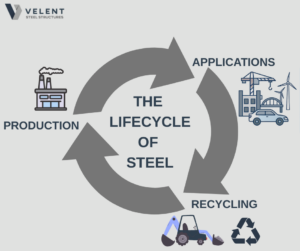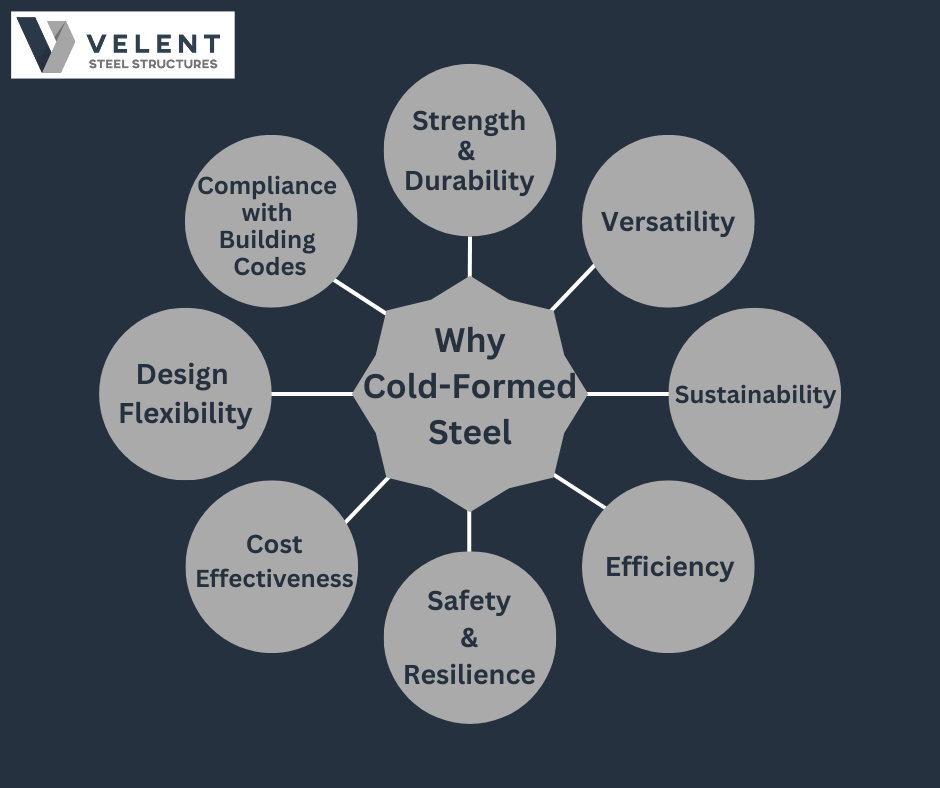Steel is integral to modern civilization, underpinning structures from towering skyscrapers to intricate machinery. Its journey from raw material to reusable resource embodies a remarkable cycle of transformation and sustainability. In this exploration, we’ll delve into the comprehensive lifecycle of steel, emphasizing its production, diverse applications, and the pivotal role of recycling in promoting environmental stewardship.

Production: The Genesis of Steel
The inception of steel involves the fusion of iron with carbon, resulting in an alloy that boasts enhanced strength and versatility. The primary methods of steel production are:
- Blast Furnace-Basic Oxygen Furnace (BF-BOF): This traditional approach entails smelting iron ore in a blast furnace, followed by refining in a basic oxygen furnace. While effective, this method is energy-intensive and contributes significantly to carbon emissions.
- Electric Arc Furnace (EAF): Utilizing scrap steel as a primary input, EAFs melt the material using high-voltage electric arcs. This process is more energy-efficient and environmentally friendly, aligning with contemporary sustainability goals.
Innovations in steel production are continually emerging. For instance, companies like Electra are pioneering electrochemical processes that produce iron at substantially lower temperatures, leveraging renewable energy sources. This method promises an 80% reduction in emissions at half the cost of traditional techniques.
Applications: Steel’s Ubiquity in Modern Life
Steel’s strength, durability, and versatility make it an essential material in nearly every industry, shaping the modern world in ways we often take for granted.
Construction
From towering skyscrapers to residential housing, steel is the backbone of modern construction. Its high strength-to-weight ratio allows architects and engineers to design taller, more resilient structures while maintaining cost efficiency. Light Gauge Steel Framing (LGSF) has further revolutionized construction, enabling faster, more sustainable, and precision-engineered building methods. Companies like Velent Steel Structures specialize in innovative steel solutions, helping developers and builders achieve stronger, safer, and more efficient projects.
Automotive
Steel plays a crucial role in automotive manufacturing, balancing strength, safety, and fuel efficiency. With the rise of Advanced High-Strength Steel (AHSS), vehicles are becoming lighter without compromising safety, improving performance and reducing emissions. In the era of electric vehicles (EVs), steel remains a key component in battery enclosures, crash-resistant structures, and lightweight chassis designs.
Infrastructure
Bridges, railways, and pipelines all depend on steel’s durability and resilience. Its ability to withstand extreme weather conditions and heavy loads makes it indispensable in large-scale infrastructure projects. Steel’s adaptability also allows for the construction of longer-lasting, lower-maintenance transportation networks, ensuring sustainable development in growing urban areas.
Energy
Steel is essential to both traditional and renewable energy sectors. It provides the structural foundation for wind turbines, solar panel mounts, and hydroelectric dams, supporting the transition to clean energy solutions. In the oil and gas industry, high-grade, corrosion-resistant steel is used in offshore rigs, refineries, and pipelines, ensuring safe and efficient energy transport.
Steel’s widespread applications highlight its indispensable role in shaping industries and driving innovation. Whether in construction, transportation, or energy, its adaptability and sustainability make it a cornerstone of modern development.
Recycling: Closing the Loop
One of steel’s most remarkable attributes is its ability to be infinitely recycled without losing its strength or quality. Unlike many other materials that degrade over time, steel can be repurposed and reused across generations, making it one of the most sustainable building materials available.
Steel recycling operates in a closed-loop system, meaning that steel products—whether from construction, automotive, or industrial applications—are melted down, reformed, and reintroduced into the production cycle with minimal waste. This not only reduces the need for raw material extraction but also significantly lowers carbon emissions, energy consumption, and landfill waste.
The efficiency of steel recycling is unparalleled. Globally, over 85% of steel products are recycled at the end of their lifecycle, feeding back into new construction, vehicles, appliances, and infrastructure. The use of Electric Arc Furnaces (EAFs) in modern steel production has further improved sustainability, as they primarily rely on recycled steel rather than newly mined iron ore, consuming up to 75% less energy than traditional steelmaking methods.
Steel recycling is a well-established and efficient process that ensures used steel is continuously reintroduced into the production cycle. The recycling process involves:
- Collection: The first step in the recycling process is the collection of scrap steel from multiple sources. This includes demolished buildings, old bridges, decommissioned vehicles, industrial manufacturing remnants, and even household appliances. Scrap yards, construction sites, and metal processing facilities serve as key collection points, ensuring that every usable piece of steel is recovered rather than wasted.
- Sorting: Once collected, steel undergoes a rigorous sorting process to separate it from other materials. Since steel is magnetic, specialized electromagnetic separators make this process highly efficient, quickly extracting steel from mixed waste streams. Advanced sorting technologies further categorize the scrap by grade and alloy composition, ensuring that the recycled steel meets the necessary specifications for future applications.
- Melting: The sorted steel is then fed into Electric Arc Furnaces (EAFs), where it is melted at extreme temperatures. This process consumes significantly less energy than traditional blast furnaces, reducing carbon emissions and lowering the overall environmental impact of steel production. The molten steel is then refined to remove impurities, adjusted for specific alloy compositions, and cast into new beams, sheets, or coils, ready to be reshaped into various products.
With increasing global emphasis on sustainable development and net-zero targets, the role of steel recycling is only set to grow, ensuring that future generations benefit from strong, durable, and eco-friendly materials without depleting the planet’s resources.
The Circular Economy and Steel
The circular economy focuses on minimizing waste and maximizing resource efficiency, and steel is a prime example of this sustainable model. Thanks to its durability and infinite recyclability, steel remains in circulation, reducing environmental impact and conserving resources.
- Reuse – Steel components from deconstructed buildings, bridges, and industrial structures can be repurposed for new projects, cutting down on material waste and costs.
- Remanufacturing – Steel parts in automotive, heavy machinery, and construction can be restored or upgraded, extending their usability and reducing the need for new production.
- Recycling – Steel retains its strength and quality through repeated recycling, significantly lowering energy consumption, carbon emissions, and demand for virgin raw materials.
By embracing reuse, remanufacturing, and recycling, industries can build a low-waste, resource-efficient future, reinforcing steel’s role as a key pillar of sustainability. Organizations like the World Steel Association highlight steel’s role in the circular economy, noting that all available steel scrap is recycled repeatedly to create new steel products.
Advancements in Sustainable Steel Production
The steel industry is actively pursuing methods to reduce its environmental footprint. Notable advancements include:
- Green Hydrogen Utilization: Companies are exploring the use of green hydrogen as a reductant in steelmaking, potentially reducing emissions by up to 90%.
- Carbon Capture and Storage (CCS): Implementing CCS technologies can capture up to 90% of CO₂ emissions from steel production processes.
- Electrolysis Techniques: Innovations in iron ore electrolysis present opportunities for near-zero emission steel production.
Conclusion
The lifecycle of steel, from production to recycling, underscores its significance as a sustainable material in modern society. Through continuous advancements in production methods and a steadfast commitment to recycling, steel stands as a testament to the possibilities of a circular economy. Its strength, durability, and infinite recyclability make it an essential material in building infrastructure, transportation, and energy systems that support global development.
As industries and consumers increasingly prioritize sustainability, steel’s role is poised to become even more pivotal in shaping a resilient and eco-friendly future. By embracing innovative manufacturing techniques, reducing carbon footprints, and optimizing recycling processes, the steel industry can drive progress toward a more sustainable, low-waste world—where resources are utilized efficiently and environmental impact is minimized for generations to come.
Looking to optimize your next project with sustainable steel solutions? Connect with our experts to explore the possibilities!


